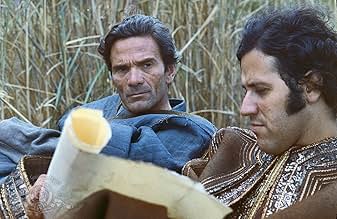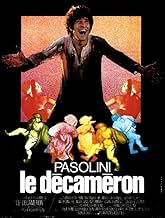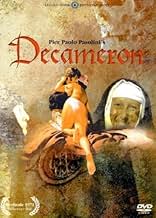VALUTAZIONE IMDb
7,0/10
12.652
LA TUA VALUTAZIONE
Un adattamento di nove storie dal "Decameron" di Boccaccio.Un adattamento di nove storie dal "Decameron" di Boccaccio.Un adattamento di nove storie dal "Decameron" di Boccaccio.
- Premi
- 1 vittoria e 3 candidature
Jovan Jovanovic
- Rustico
- (scene tagliate)
Maria Gabriella Maione
- Una madonna
- (as Gabriella Frankel)
Pier Paolo Pasolini
- Allievo di Giotto
- (as P.P. Pasolini)
Trama
Lo sapevi?
- QuizIl Decameron (1971) is the first film in Pier Paolo Pasolini's "Trilogy of Life," continuing with I racconti di Canterbury (1972) and concluding with Il fiore delle mille e una notte (1974). Each film was an adaptation of a different piece of classical literature focusing on ribald and often irreligious themes. The tales contain abundant nudity, sex, slapstick and scatological humor.
- BlooperWhen the Mother Superior seduces the deaf-mute boy, he's sleeping in a tomato garden. Tomatoes are a New World crop that wouldn't be brought to Italy for another two centuries. The same is true of the corn (maize) growing in the convent's little field.
- Citazioni
Allievo di Giotto: Why create a work of art when dreaming about it is so much sweeter?
- Versioni alternativeAlthough the cinema version was intact the 1988 UK Warner video was cut by 22 secs by the BBFC to remove shots of naked genitals during the bedroom sex scene with the nun. The cuts were fully restored in the 2001 BFI DVD release.
- ConnessioniEdited into Porno e libertà (2016)
- Colonne sonoreFenesta Ca Lucive
Written by Guglielmo Cottrau, Vincenzo Bellini and Giulio Genoino in 1842
Performed by Franco Citti
Sung by Ser Ciappelletto and his Neapolitan hosts in Germany. Also sung by one of the Neapolitans to a monk.
Recensione in evidenza
Film lovers know "Andrei Rublov," that Russian film about an icon painter. The beauty of the film comes in part because the filmmaker is on the same quest as his character, and that quest has as its core the discovery of beauty. The interesting thing about movies is that they create and sustain a fantasy world that lives beyond any one movie and into which we assume each movie is born. That world has its own type of beauty, one born of color and glamor and poise.
Paosolini does the same thing as Tarkovsky, but where Tarkovsky dealt with cosmic beauty and recognition, this artist has simpler goals: to engage with flesh, to flow with the simple streams of ignoble daily motion, and to discover beauty in that plain world.
Oh, what a terrific cinematic place to visit! This is a far from that collection of movie metaphors and beauty as we can go. There is no movie acting here. There is no external beauty. There is no recourse to familiar characters or representation. As usual, he draws his source material from matter that is not only before cinema, but before any popular writing.
And he works with that material outside any movie tricks. Well, he still has that Italian tendency to believe that the world is populated by characters and not situations or any sort of fateful flow. Just people who do things. Lots of little things, usually associated with pleasure.
So if you are building a world of cinematic imagination you need to have this as one of your corners. That's silly, every one of us is building a cinematic imagination we cannot avoid it. What I mean to say is that if you are building an imagination, some of which you understand and can use, some of which you actually want and can enjoy without being sucked into reflex...
If you want to just relate to people as people and test how easy it is to find grace in the strangest of faces, then this is your movie voyage for the night.
One rather shocking thing is how the nudity works. In "ordinary" film, we thing nothing of seeing two people humping and moaning, nude pelvises grinding is the most hungry of ways. But we gasp when some genital is shown. Here, the exact reverse is found: no shyness about the obvious existence of genitals, an erection even. A sleeping girl with her hand in her lover's crotch. DIsplayed as if it were in the same cinematic territory as the faces he finds.
But when these characters lay on each other for sex, we have the most prurient of actor's postures. I think this was done simply to avoid an automatic sweep into ordinary film ways. It has that effect anyway.
I don't know anyone that chooses more interesting faces. Distinctly Southern European, odd atypical faces.
And finally, there is the bit of his own story inserted, the artist in the church. Creating scenarios of rich life. In the movie, the most amazing scenes are those that have little or nothing to do with the story. There's a "death" tableau that could be the richest single shot I have ever seen, anywhere.
Ted's Evaluation -- 3 of 3: Worth watching.
Paosolini does the same thing as Tarkovsky, but where Tarkovsky dealt with cosmic beauty and recognition, this artist has simpler goals: to engage with flesh, to flow with the simple streams of ignoble daily motion, and to discover beauty in that plain world.
Oh, what a terrific cinematic place to visit! This is a far from that collection of movie metaphors and beauty as we can go. There is no movie acting here. There is no external beauty. There is no recourse to familiar characters or representation. As usual, he draws his source material from matter that is not only before cinema, but before any popular writing.
And he works with that material outside any movie tricks. Well, he still has that Italian tendency to believe that the world is populated by characters and not situations or any sort of fateful flow. Just people who do things. Lots of little things, usually associated with pleasure.
So if you are building a world of cinematic imagination you need to have this as one of your corners. That's silly, every one of us is building a cinematic imagination we cannot avoid it. What I mean to say is that if you are building an imagination, some of which you understand and can use, some of which you actually want and can enjoy without being sucked into reflex...
If you want to just relate to people as people and test how easy it is to find grace in the strangest of faces, then this is your movie voyage for the night.
One rather shocking thing is how the nudity works. In "ordinary" film, we thing nothing of seeing two people humping and moaning, nude pelvises grinding is the most hungry of ways. But we gasp when some genital is shown. Here, the exact reverse is found: no shyness about the obvious existence of genitals, an erection even. A sleeping girl with her hand in her lover's crotch. DIsplayed as if it were in the same cinematic territory as the faces he finds.
But when these characters lay on each other for sex, we have the most prurient of actor's postures. I think this was done simply to avoid an automatic sweep into ordinary film ways. It has that effect anyway.
I don't know anyone that chooses more interesting faces. Distinctly Southern European, odd atypical faces.
And finally, there is the bit of his own story inserted, the artist in the church. Creating scenarios of rich life. In the movie, the most amazing scenes are those that have little or nothing to do with the story. There's a "death" tableau that could be the richest single shot I have ever seen, anywhere.
Ted's Evaluation -- 3 of 3: Worth watching.
I più visti
Accedi per valutare e creare un elenco di titoli salvati per ottenere consigli personalizzati
- How long is The Decameron?Powered by Alexa
Dettagli
- Data di uscita
- Paesi di origine
- Lingue
- Celebre anche come
- The Decameron
- Luoghi delle riprese
- Aziende produttrici
- Vedi altri crediti dell’azienda su IMDbPro
Botteghino
- Lordo in tutto il mondo
- 839 USD
- Tempo di esecuzione1 ora 51 minuti
- Mix di suoni
- Proporzioni
- 1.85 : 1
Contribuisci a questa pagina
Suggerisci una modifica o aggiungi i contenuti mancanti

Divario superiore
By what name was Il Decameron (1971) officially released in Canada in French?
Rispondi



























